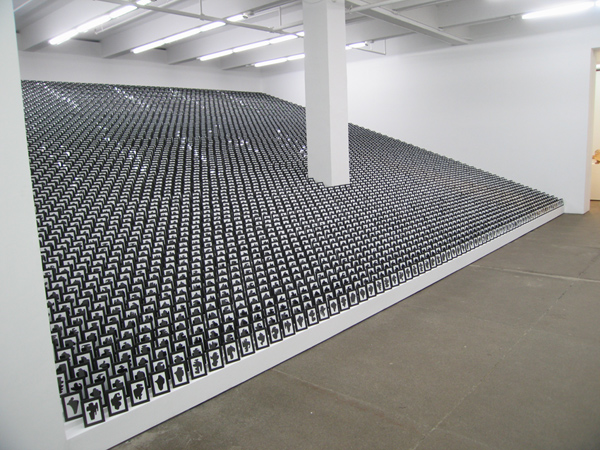 Allan McCollum. The SHAPES Project. 7,056 SHAPES Monoprints, each unique. Framed digital prints, 4.25 x 5.5 inches each. Installation: Friedrich Petzel Gallery, New York.
The Shape of
Putting a human face on the impending SHAILESH RAO
Allan McCollum's exploratory studies of the relationship between large-scale production and ideological inconsistencies inherent to the economics of the art world date back to his 1978 installation, "Surrogate Paintings" — a potentially endless series of similar, although uniquely sized, faux-frames generally painted in single colors and hung in expansive groups. McCollum's meta-investigation into institutionalized art's assignation of value reaches new heights with "The Shapes Project," a system devised to generate 31 billion unique graphic shapes in response to worldwide population growth. With current estimates predicting a peak of up to 20 billion people by 2050, the artist wanted to insure that each person would have one piece to call their own. Trading paint and plaster for Adobe Illustrator and Vector graphics, McCollum developed a library of arcs and curves, which are combined to create the four or six sector graphic icons. He hopes to combat the impersonal sterility of raw numbers, crossing the systematic with the biomorphic aspects of his symbols (rounded corners, top-heavy silhouettes and face-like features) to humanize otherwise daunting figures, to give them a more approachable character and an immediately recognizable sense of individuality. Up to this point, McCollum has configured over 200 million of these abstractions, which are all meticulously catalogued. Using these basic production techniques to manufacture myriad one-of-a-kind objects, he crafts universal artworks that are paradoxically unique. "My projects all grow out of my discomfort with the directive that artists must create original, fairly rare pieces," observes McCollum. As he sees it, mass production is intrinsically linked to singularity, and, in order to truly understand the value of objects in contemporary society, you have to think through this dichotomy. "Why can't things be art if they are produced in mass quantities?" the artists asks. "All of my work tries to resolve this distinction." McCollum's interest in monumental numbers is coupled with a critique of how institutionalized art derives its meaning, and thus, its value. With "Shapes" — as with his 1987 "Individual Works," several thousand of which MoMA recently acquired — he exposes the denial that grounds the elitist attitude of the art market. "Most artists would like their work to be copied, but in order to survive, you have to make pieces wealthy people want to buy, pieces that are easily fetishized." Working with mass quantities also enables him to examine the related concept that art functions to distinguish one group from another, establishing a physical correlative to how we separate people. "It's perfectly normal to divide people into categories," says McCollum. "But culture gets sloppy when imagining 'the masses' — they use words like 'all, everyone, people.'" Offering an explanation for the lack of investigation into how to represent huge quantities, the artist simply states, "I think we are scared of the problem." But "Shapes" seems to provide a visual solution to this representational dilemma. "Images offer another way to perceive large numbers, so, instead of looking to one flag and saying 'that's our country,' we now have 31 billion shapes to represent each of us. We need to question the way we use our symbols, because for every reason we have to unify ourselves under a single symbol, there are many more for doing the opposite." |